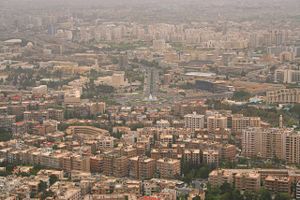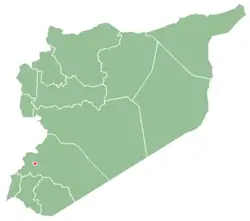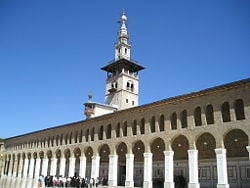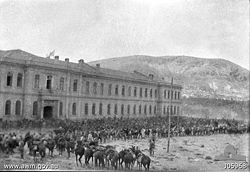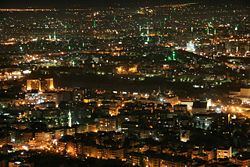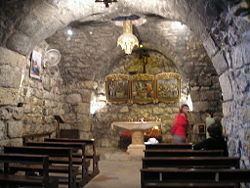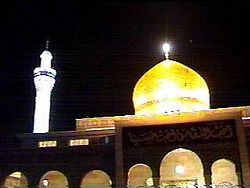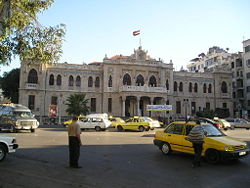Difference between revisions of "Damascus" - New World Encyclopedia
| Line 181: | Line 181: | ||
==Damascus today== | ==Damascus today== | ||
| − | == Historical sites == | + | ===Historical sites=== |
[[Image:Damascus-Ananias chapel.jpg|thumb|250px|right|Ananias Chapel.]] | [[Image:Damascus-Ananias chapel.jpg|thumb|250px|right|Ananias Chapel.]] | ||
[[Image:Shrine Zaynab.jpg|thumb|right|250px|Shrine of Zaynab bint Ali at Damascus, Syria.]] | [[Image:Shrine Zaynab.jpg|thumb|right|250px|Shrine of Zaynab bint Ali at Damascus, Syria.]] | ||
Revision as of 12:59, 7 September 2007
| Damascus دمـشق |
|||
| Damascus Skyline | |||
|
|||
| Nickname: (Al Fayhaa) The Fragrant City | |||
| The Seal of the Damascus Governorate | |||
| Syria | Syria | ||
|---|---|---|---|
| Governorates | Damascus Governorate | ||
| Government | |||
| - Governor | Bishr Al Sabban | ||
| Elevation | Expression error: Unrecognized punctuation character ",". m (1,969 ft) | ||
| Population (2005) | |||
| - Total | 4,500,000 (~6,500,000 metro. area) | ||
| Time zone | UTC/GMT +2 hours (UTC+3) | ||
| - Summer (DST) | CEST (UTC) | ||
Damascus (دمشق transliteration: Dimashq, also commonly known as الشام ash-Shām) is the capital and largest city of Syria. It is thought to be among the oldest continuously inhabited cities in the world. Its current population is estimated at about 4.5 million. The city is a governorate by itself, and the capital of the governorate of Rif Dimashq ("rural Damascus"). Damascus lies in the Ghutah oasis, and is fed with water by the Barada River.
According to the Old Testament, Damascus was the capital of the Aramean Kingdom in the eleventh century B.C.E. In the tenth century B.C.E., the Hebrews and Assyrians attacked the city. In 732 B.C.E., Tiglath Pileser II of Judea claimed the city. Later, Damascus was destroyed by Babylon. In 333 B.C.E., the Greeks took it from the Persians. It later fell to the Seleucids, and in 66 B.C.E. it was occupied by Pompey. On the way to Damascus, St. Paul, who was sent to put down the Christians, had the revelation of faith. On arriving, he met Ananias and together they preached for Christ.
Later, Damascus became a base for the Byzantine Empire, then it was retaken by Khaled Ibn al Waleed in 636, shifting the city from Byzantium and Christianity to the Orient and the Semitic world. Under Islam, it became the capital of an empire spreading from the Atlantic coast to central Asia, the Umayyad Empire. This golden age ended with the Abbassids, who moved the capital to Baghdad. From then on, it fell under the power of various Muslim sovereigns, most importantly the Egyptian Fatimids. Saladin took it from the Fatimids and started the Ayyubid Dynasty, battling against the the Crusaders. Numerous monuments built by Nur al Din and Saladin are still the pride of Damascus.
In 1260, the Mamelukes of Egypt pushed the Mongols back and took the city. In 1516, the Ottomans Turks held Damascus until World War I, after which the city was liberated in 1918. The Syrian National Congress was formed in 1919, with Emir Faisal named King of Syria in 1920, and one month later was taken over by the French in the name of the League of Nations. After a few uprisings, Syria was proclaimed Independent on September 16, 1941.
Damascus is made up of a sizeable old city, divided into the market area, Muslim area, Christian area, and the Jewish area. All three religions are still represented in Damascus, even if the Jewish community now only counts a few thousand. The modern city is mainly grey with little green, and most of the modern buildings are influenced by Syria's weak economy. There is a university, many museums, and embassies.
The Ancient City of Damascus was selected as UNESCO World Heritage site, in 1979.
World Heritage site
According to UNESCO, the Ancient City of Damascus, selected as a World Heritage Site, is one of the oldest cities in the Middle East. In the Middle Ages, it was the center of a flourishing craft industry, specializing in swords and lace. The city has some 125 monuments from different periods of its history—one of the most spectacular is the eighth-century Great Mosque of the Umayyads, built on the site of an Assyrian sanctuary.
The key criteria for its selection as a World Heritage site, were that Damascus: represented a masterpiece of human creative genius; exhibits an important interchange of human values, over a span of time or within a cultural area of the world, on developments in architecture or technology, monumental arts, town planning or landscape design; bore a unique or at least exceptional testimony to a cultural tradition or to a civilization which is living or which has disappeared; was an outstanding example of a type of building, architectural or technological ensemble or landscape which illustrates (a) significant stage(s) in human history; and was directly or tangibly associated with events or living traditions, with ideas, or with beliefs, with artistic and literary works of outstanding universal significance.
Name
In Arabic, the city is called Dimashq ash-Shām, although this is often shortened to either Dimashq or ash-Shām by the citizens of Damascus, the rest of Syria, and some other Arab neighbors. Ash-Shām is an Arabic term for north and for Syria.
Syria, particularly historical Greater Syria, is sometimes called called, in Arabic, Bilād ash-Shām ("land of the north," or "land of Shem [son of Noah]"), but with Shem being from the native Syriac language.) The etymology of the ancient name "Damascus" is uncertain, but it is suspected to be pre-Semitic.
Geography
Damascus lies about 50 miles inland from the Mediterranean Sea, sheltered by the Anti-Lebanon Mountains. It lies on a plateau 423 feet above sea-level. The old city of Damascus, enclosed by the city walls, lies on the south bank of the Barada River. To the southeast, north, and northeast, Dasmacus is surrounded by suburban areas whose history stretches back to the Middle Ages: Midan in the southwest, Sarouja and Imara in the north and northwest. These districts originally arose on roads leading out of the city, near the tombs of religious figures.
In the nineteenth century, outlying villages developed on the slopes of Jabal Qasioun overlooking the city, on the site of the Salihiyye district centered around the important shrine of Sheikh Muhi al-Din ibn Arabi. These new districts were initially settled by Kurdish soldiers and Muslim refugees from the European regions of the Ottoman Empire that had fallen under Christian rule. Thus, they were known as al-Akrad ("the Kurds"); and al-Muhajirin ("the migrants"). They lay 1.25 to 1.9 miles north of the old city.
From the late-nineteenth century on, a modern administrative and commercial center began to spring up to the west of the old city, around the Barada, centred on the area known as al-merjeh ("the meadow.") Al-Merjeh soon became the name of what was initially the central square of modern Damascus, with the city hall located there. The courts of justice, post office and railway station stood on higher ground slightly to the south. A European-style, residential quarter soon began to be built on the road leading between al-Merjeh and Salihiyye. The commercial and administrative center of the new city gradually shifted northwards slightly towards this area.
In the twentieth century, newer suburbs developed north of the Barada, and to some extent to the south, invading the Ghouta oasis. From 1955, the new district of Yarmouk became a second home to thousands of Palestinian refugees. City planners preferred to preserve the Ghouta as far as possible. In the later twentieth century, some of the main areas of development were to the north, in the western Mezze district, and, most recently, along the Barada valley in Dumar in the northwest and on the slopes of the mountains at Berze in the northeast. Poorer areas, often built without official approval, have mostly developed south of the main city.
Damascus is surrounded by an oasis, the Ghouta (الغوطة al-ġūṭä), watered by the Barada. The Fijeh spring, west along the Barada valley, provides the city with drinking water. The Ghouta oasis has been decreasing in size with the rapid expansion of housing and industry in the city. It has also become polluted due to the city's traffic, industry, and sewage.
History
| Ancient City of Damascus* | |
|---|---|
| UNESCO World Heritage Site | |
Damascus at sunset | |
| State Party | |
| Type | Cultural |
| Criteria | i, ii, iii, iv, vi |
| Reference | 20 |
| Region** | Arab States |
| Inscription history | |
| Inscription | 1979 (3rd Session) |
| * Name as inscribed on World Heritage List. ** Region as classified by UNESCO. | |
Ancient history
Excavations at Tell Ramad on the outskirts of the city have shown that Damascus has been inhabited as early as 8000 to 10,000 B.C.E. Based on this finding, Damascus is considered to be among the oldest continually inhabited city in the world. However, Damascus is not documented as an important city until the arrival of the Aramaeans, Semitic nomads who arrived from the Arabian peninsula. It is known that it was the Aramaeans who first established the water-distribution system of Damascus by constructing canals and tunnels which maximized the efficiency of the Barada River. The same network was later improved by the Romans and the Umayyads, and still forms the basis of the water system of the old part of Damascus today. It was mentioned in Genesis 14 as existing at the time of the War of the Kings, although the historicity of this account has been questioned.
According to the 1st century Jewish historian Flavius Josephus in his 21-volume Antiquities of the Jews,
- "Nicolaus of Damascus, in the fourth book of his History, says thus: "Abraham reigned at Damascus, being a foreigner, who came with an army out of the land above Babylon, called the land of the Chaldeans: but, after a long time, he got him up, and removed from that country also, with his people, and went into the land then called the land of Canaan, but now the land of Judea, and this when his posterity were become a multitude; as to which posterity of his, we relate their history in another work. Now the name of Abraham is even still famous in the country of Damascus; and there is shown a village named from him, The Habitation of Abraham."
Damascus is designated as having been part of the ancient province of Amurru in the Hyksos Kingdom, from 1720 to 1570 B.C.E. Some of the earliest Egyptian records are from the 1350 B.C.E. Amarna letters, when Damascus-(called Dimasqu) was ruled by king Biryawaza. In 1100 B.C.E., the city became the center of a powerful Aramaean state called Aram Damascus. The Kings of Aram Damascus were involved in many wars in the area against the Assyrians and the Israelites. One of the Kings, Ben-Hadad II, fought Shalmaneser III at the Battle of Qarqar. The ruins of the Aramean town most probably lie under the eastern part of the old walled city. After Tiglath-Pileser III captured and destroyed the city in 732 B.C.E., it lost its independence for hundreds of years, and it fell to the Neo-Babylonian Empire of Nebuchadnezzar starting in 572 B.C.E. The Babylonian rule of the city came to an end in 538 B.C.E. when the Persians under Cyrus captured the city and made it the capital of the Persian province of Syria.
Greco-Roman
Damascus first came under western control with the giant campaign of Alexander the Great that swept through the Near East. After the death of Alexander in 323 B.C.E., Damascus became the site of a struggle between the Seleucid and Ptolemaic empires. The control of the city passed frequently from one empire to the other. Seleucus Nicator, one of Alexander's generals, had made Antioch the capital of his vast empire, a decision that led Damascus' importance to decline compared with the newly founded Seleucid cities such as Latakia in the north.
In 64 B.C.E., Pompey and the Romans annexed the western part of Syria. They occupied Damascus and subsequently incorporated it into the league of 10 cities known as the Decapolis because it was considered such an important center of Greco-Roman culture. According to the New Testament, St. Paul was on the road to Damascus when he received a vision, was struck blind, and as a result converted to Christianity. In the year 37, Roman Emperor Caligula transferred Damascus into Nabataean control by decree. The Nabataean king Aretas IV Philopatris ruled Damascus from his capital Petra. However, around the year 106, Nabataea was conquered by the Romans, and Damascus returned to Roman control.
Damascus became a metropolis by the beginning of the second century, and in 222 it was upgraded to a colonia by the Emperor Septimius Severus. With the coming of the Pax Romana, Damascus and the Roman province of Syria in general began to prosper. Damascus's importance as a caravan city was evident with the trade routes from southern Arabia, Palmyra, Petra, and the silk routes from China all converging on it. The city satisfied the Roman demands for eastern luxuries.
Little remains of the architecture of the Romans, but the town planning of the old city did have a lasting effect. The Roman architects brought together the Greek and Aramaean foundations of the city and fused them into a new layout measuring approximately 4,921 by 2,461 feet, surrounded by a city wall. The city wall contained seven gates, but only the eastern gate (Bab Sharqi) remains from the Roman period. Roman Damascus lies mostly at depths of up to 16.4 feet below the modern city.
From the Muslim conquest to the Fatimids
Damascus was conquered by the Caliph Umar I in 636. Immediately thereafter, the city's power and prestige reached its peak when it became the capital of the Umayyad Empire, which extended from Spain to India from 661 to 750. In 744, the last Umayyad caliph, Marwan II, moved the capital to Harran in the Jazira, and Damascus was never to regain the political prominence it had held in that period.
After the fall of the Umayyads and the establishment of the Abbasid caliphate in 750, Damascus was ruled from Baghdad, although in 858 al-Mutawakkil briefly established his residence there with the intention of transferring his capital there from Samarra. However, he soon abandoned the idea. As the Abbasid caliphate declined, Damascus suffered from the prevailing instability, and came under the control of local dynasties. In 875, the ruler of Egypt, Ahmad ibn Tulun, took the city, with Abbasid control being re-established only in 905. In 945, the Hamdanids took Damascus, and not long after it passed into the hands of Muhammad bin Tughj, founder of the Ikhshidid dynasty. In 968, and again in 971, the city was briefly captured by the Qaramita.
Fatimids, the Crusades, and the Seljuks
In 970, the Fatimid Caliphs in Cairo gained control of Damascus. This was to usher in a turbulent period in the city's history, as the Berber troops who formed the backbone of the Fatimid forces became deeply unpopular among its citizens. The presence in Syria of the Qaramita and occasionally of Turkish military bands added to the constant pressure from the Bedouin. For a brief period from 978, Damascus was self-governing, under the leadership of a certain Qassam and protected by a citizen militia. However, the Ghouta was ravaged by the Bedouin and after a Turkish-led campaign the city once again surrendered to Fatimid rule. From 1029 to 1041, the Turkish military leader Anushtakin was governor of Damascus under the Fatimid caliph Al-Zahir, and did much to restore the city's prosperity.
It appears that during this period the slow transformation of Damascus from a Graeco-Roman city layout—characterized by blocks of insulae—to a more familiar Islamic pattern took place: the grid of straight streets changed to a pattern of narrow streets, with most residents living inside harat closed off at night by heavy wooden gates to protect against criminals and the exactions of the soldiery.
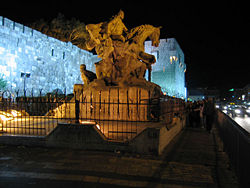
With the arrival of the Seljuk Turks in the late-eleventh century, Damascus again became the capital of independent states. It was ruled by a Seljuk dynasty from 1079 to 1104, and then by another Turkish dynasty—the Burid Emirs, who withstood a siege of the city during the Second Crusade in 1148. In 1154, Damascus was conquered from the Burids by the famous Zengid Atabeg Nur ad-Din of Aleppo, the great foe of the Crusaders. He made it his capital, and following his death, it was acquired by Saladin, the ruler of Egypt, who also made it his capital. Saladin rebuilt the citadel, and it is reported that under his rule the suburbs were as extensive as the city itself. It is reported by Ibn Jubayr that during the time of Saladin, Damascus welcomed seekers of knowledge and industrious youth from around the world, who arrived for the sake of "undistracted study and seclusion" in Damascus' many colleges.
In the years following Saladin's death, there were frequent conflicts between different Ayyubid sultans ruling in Damascus and Cairo. Damascus steel gained a legendary reputation among the Crusaders, and patterned steel is still called "damascened." The patterned Byzantine and Chinese silks available through Damascus, one of the Western termini of the Silk Road, gave the English language "damask."
Mamluk rule
Ayyubid rule (and independence) came to an end with the Mongol invasion of Syria in 1260, and Damascus became a provincial capital of the Mamluk Empire, ruled from Egypt, following the Mongol withdrawal.
Timur sacks Damascus
In 1400 Timur, the Mongol conqueror, besieged Damascus. The Mamluk sultan dispatched a deputation from Cairo, including Ibn Khaldun, who negotiated with him, but after their withdrawal, he put the city to sack. The Umayyad Mosque was burnt and men and women taken into slavery. A huge number of the city's artisans were taken to Timur's capital at Samarkand. These were the luckier citizens: many were slaughtered and their heads piled up in a field outside the northeast corner of the walls, where a city square still bears the name burj al-ruus ("the tower of heads.")
Rebuilt, Damascus continued to serve as a Mamluk provincial capital until 1516 .
The Ottoman conquest
In early 1516, the Ottoman Turks, wary of the danger of an alliance between the Mamluks and the Persian Safavids, started a campaign of conquest against the Mamluk sultanate. On September 21, the Mamluk governor of Damascus fled the city, and on October 2, the khutba in the Umayyad mosque was pronounced in the name of Selim I. The day after, the victorious sultan entered the city, staying for three months. On December 15, he left Damascus by Bab al-Jabiya, intent on the conquest of Egypt. Little appeared to have changed in the city: one army had simply replaced another. However, on his return in October 1517, the sultan ordered the construction of a mosque, taqiyya and mausoleum at the shrine of Shaikh Muhi al-Din ibn Arabi in Salihiyya. This was to be the first of Damascus' great Ottoman monuments.
The Ottomans remained for the next 400 years, except for a brief occupation by Ibrahim Pasha of Egypt from 1832 to 1840. Because of its importance as the point of departure for one of the two great Hajj caravans to Mecca, Damascus was treated with more attention by the Porte than its size might have warranted—for most of this period, Aleppo was more populous and commercially more important. In 1560, the Taqiyya al-Sulaimaniyya, a mosque and khan for pilgrims on the road to Mecca, was completed based on a design by the famous Ottoman architect Sinan, and soon afterwards a madrasa was built adjoining it.
Perhaps the most notorious incident of these centuries was the massacre of Christians in 1860, when fighting between Druze and Maronites in Mount Lebanon spilled over into the city. Some thousands of Christians were killed, with many more being saved through the intervention of the Algerian exile Abd al-Qadir and his soldiers, who brought them to safety in Abd al-Qadir's residence and the citadel. The Christian quarter of the old city, including a number of churches, was burnt down. The Christian inhabitants of the notoriously poor and refractory Midan district outside the walls were, however, protected by their Muslim neighbors.
Rise of Arab nationalism
In the early years of the twentieth century, nationalist sentiment in Damascus, initially cultural in focus, began to take a political perspective, largely in reaction to the turkicisation program of the Committee of Union and Progress government established in Istanbul in 1908. The hanging of a number of patriotic intellectuals by Jamal Pasha, governor of Damascus, in Beirut and Damascus, in 1915 and 1916, further stoked nationalist feeling, and in 1918, as the forces of the Arab Revolt and the British army approached, residents fired on the retreating Turkish troops.
Modern
On October 1, 1918, the forces of the Arab revolt led by Nuri as-Said entered Damascus. The same day, Australian soldiers from the fourth and tenth Light Horse Regiments, reinforced with detachments from the British Yeomanry Mounted Division, entered the city and accepted its surrender from the Turkish appointed Governor Emir Said (installed as Governor the previous afternoon by the retreating Turkish Commander). The military government under Shukri Pasha was named.
Other British forces, including T. E. Lawrence, followed later that day, and Faisal ibn Hussein was proclaimed king of Syria. Political tension rose in November 1917, when the new Bolshevik government in Russia revealed the Sykes-Picot Agreement, whereby Britain and France had arranged to partition the Arab east between them. A new Franco-British proclamation on November 17 promised the "complete and definitive freeing of the peoples so long oppressed by the Turks." In March, the Syrian Congress adopted a democratic constitution. However, the Versailles Conference had granted France a mandate over Syria. In 1920, a French army crossed the Anti-Lebanon Mountains, defeated a small Syrian defensive expedition at the Battle of Maysalun, and entered Damascus. The French made Damascus capital of their League of Nations Mandate of Syria.
When in 1925 the Druze revolt in the Hauran spread to Damascus, the French repressed it brutally, bombing and shelling the city. The area of the old city between Souk al-Hamidiyya and Souk Midhat Pasha was burned to the ground, with many deaths, and has since then been known as al-Hariqa ("the fire"). The old city was surrounded with barbed wire to prevent rebels infiltrating from the Ghouta, and a new road was built outside the northern ramparts to facilitate the movement of armored cars.
On June 21, 1941, Damascus was captured from the Vichy French forces by the Allies during the Syria-Lebanon campaign.
In 1945, the French once more bombed Damascus, but on this occasion British forces intervened and the French agreed to withdraw, thus leading to the full independence of Syria in 1946 . Damascus remained the capital.
Damascus today
Historical sites
Damascus has a wealth of historical sites dating back to many different periods of the city's history. Since the city has been built up with every passing occupation, it has become almost impossible to excavate all the ruins of Damascus that lie up to eight feet below the modern level. The Citadel of Damascus is located in the northwest corner of the Old City. The street called straight (referred to in the conversion of St. Paul in Acts 9:11), also known as the Via Recta, was the decumanus (East-West main street) of Roman Damascus, and extended for over 4,921 feet. Today, it consists of the street of Bab Sharqi and the Souk Medhat Pasha, a covered market. The Bab Sharqi street is filled with small shops and leads to the old Christian quarter of Bab Touma (St. Thomas's Gate). Souq Medhat Pasha is also a main market in Damascus and was named after Medhat Pasha, the Ottoman governor of Damascus who renovated the Souq. At the end of the Bab Sharqi street, one reaches the House of Ananias, an underground chapel that was the cellar of Ananias's house.
The Umayyad Mosque, also known as the Grand Mosque of Damascus, is one of the largest mosques in the world, and one of the oldest sites of continuous prayer since the rise of Islam. A shrine in the mosque is said to contain the head of John the Baptist.
A heavily visited site is the tomb of Zaynab bint Ali. Hundered of thousands of shia muslims visit it every year.
Education
Damascus is the main center of education in Syria. It is home to Damascus University, which is the oldest and by far the largest university in Syria. After the enactment of legislation allowing private secondary institutions, several new universities were established in the city and in the surrounding area. Additional, higher-learning institutions include: Syrian Virtual University, Syrian European University, Higher Institute of Applied Science and Technology HIAST, International University for Science and Technology, and Higher Institute of Business Administration HIBA.
Transportation
The main airport is Damascus International Airport, approximately 12 miles away from the city center, with connections to many Asian, Europe, African, and recently, South American cities.
Streets in Damascus are often narrow, mostly in the older parts of the city, and speed bumps are widely used to limit the speed.
Public transport in Damascus depends extensively on minibuses. There are about 100 lines that operate inside the city, and some of them extend from the city center to nearby suburbs. There is no schedule for the lines, and due to the limited number of official bus stops, buses will usually stop wherever a passenger needs to get on or off. The number of buses serving the same line is relatively high, which minimizes the waiting time. Lines are not numbered, rather they are given captions, mostly indicating the two end points and possibly an important station along the line.
Al-Hijaz railway station, lies in the city center. Currently this station is closed, and railway connections with other cities take place in the suburbs.
Since the early 1990s, there have been many plans to construct an underground system in Damascus, but no plan was taken seriously due to both financial and technical limitations.
Culture
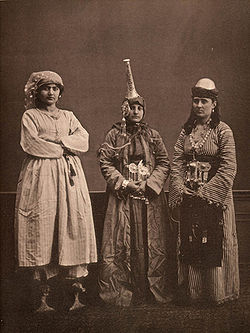
The majority of the population in Damascus came as a result of rural-urban migration. It is believed that the local people of Damascus, called Damascene, are about 1.5 million. Damascus is considered by most people to be a very safe city. Haggling is common, especially in the traditional souks. Corruption is widespread, but in the past few years there have been aims at combating it, by both the government and non-governmental organizations. Tea is arguably the favorite beverage in Damascus.
The majority of Damascenes—about 75 percent—are Sunni Muslims. It is believed that there are more than 1,000 mosques in Damascus, the most famous one being the Umayyad Mosque. There are some Christian districts, such as Bab Touma, Kassaa, and Ghassani, with many churches, most notably the ancient St. Paul's Church.
Museums in Damascus, include: the Syrian National Museum, Azem Palace, the Military Museum, and the Museum of Arabic Calligraphy.
Leisure activities
Of the parks and gardens of Damnascus, Tishreen Park is by far the largest. It is home to the annual Damascus Flower Show. Other parks include Aljahiz, Altijara, and Alwahda. Damascus oasis is also a popular destination for recreation.
Cafes are popular meeting spots for Damascene, where Arghilehs (water pipes) and popular beverages are served. Card games and Tables are popular in the cafes, including (backgammon variants) and chess.
In Damascus, popular sports include football, basketball, swimming, and table tennis. Damascus is home to many sports clubs, such as: Al Jaish, Al Wahda, Al Majd, and Al Jalaa.
ReferencesISBN links support NWE through referral fees
- Burns, Ross. Damascus: A History, Routledge, 2007. ISBN 978-0415413176
- Burns, Ross. Monuments of Syria, I.B. Tauris, 2000. ISBN 978-1860642449
- Degeorge, Gerard. Damascus, Flammarion, 2005. ISBN 978-2080304568
- Keenan, Brigid, & Beddon, Tim. Damascus. Hidden Treasures of the Old City, Thames & Hudson, 2001. ISBN 978-0500282991
External links
- The modern side of Damascus, newer buildings, the traffic, streets, shops, smiling syrians.
- The ancient side of Damascus, hours spent walking through the famous old city.
- Discovering the colorful life inside the Damascene souk.
- In and around the magnificent Umayyad Mosque.
- Visiting the splendid Azem Palace.
- Syria News Wire: Named after the ancient Saroujah area of Damascus, this site has daily tales from the streets of Damascus
- Damascus Syria News
- Damascus online
- Ancient Route history of Damascus
- Oldamascus.com, a web site devoted to the city
Credits
New World Encyclopedia writers and editors rewrote and completed the Wikipedia article in accordance with New World Encyclopedia standards. This article abides by terms of the Creative Commons CC-by-sa 3.0 License (CC-by-sa), which may be used and disseminated with proper attribution. Credit is due under the terms of this license that can reference both the New World Encyclopedia contributors and the selfless volunteer contributors of the Wikimedia Foundation. To cite this article click here for a list of acceptable citing formats.The history of earlier contributions by wikipedians is accessible to researchers here:
The history of this article since it was imported to New World Encyclopedia:
Note: Some restrictions may apply to use of individual images which are separately licensed.
